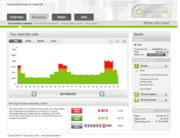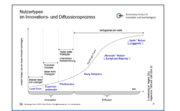Click here to register!
Difference between revisions of "The User in the Energy System - Interfering Factor or Actor?"
***** (***** | *****) |
***** (***** | *****) |
||
| Line 42: | Line 42: | ||
[[File:Smart Meter.png|thumb|180px|This information is provided by a smart meter]]Technology is invented to assist users.This example shows how technology does NOT support users. On the picture on the right side you can see... What can you see? The designers of the smart meter giving this graph, meant it to show what amount of energy was used at what time. But what the user actually wants to know is: How can I save energy? The graph on the rigth side shows some peak loads that are coloured in red but it does not recommend to buy a new refridgerator or to turn off the plugs connected with the charging cable. | [[File:Smart Meter.png|thumb|180px|This information is provided by a smart meter]]Technology is invented to assist users.This example shows how technology does NOT support users. On the picture on the right side you can see... What can you see? The designers of the smart meter giving this graph, meant it to show what amount of energy was used at what time. But what the user actually wants to know is: How can I save energy? The graph on the rigth side shows some peak loads that are coloured in red but it does not recommend to buy a new refridgerator or to turn off the plugs connected with the charging cable. | ||
| + | |||
== Helping to design and spreading the word == | == Helping to design and spreading the word == | ||
| − | [[File:Intervention Strategies.png|thumb|180px|Strategies to intervene with users]] | + | === Intervention strategies === |
| + | [[File:Intervention Strategies.png|thumb|180px|Strategies to intervene with users]][[File:Diffusion of social inventions.png|thumb|180px|The number of purchased gadgets varies over time]] | ||
| + | If user behaviour is to be changed in a sustainable way, it should be clear at what stage on the way to an altered behaviour the user is. According to Bamberg there are four steps: | ||
| + | |||
| + | 1. Precontemplation | ||
| + | |||
| + | 2. Contemplation | ||
| + | |||
| + | 3. Preparation/Test | ||
| + | |||
| + | 4. Maintenance | ||
| + | |||
| + | |||
| + | |||
| + | To go from step 1 to step 2 a goal intention has to be formulated ("I want to save energy."). To get from step 2 to step 3 a behavioural intention has to be formulated ("I want to defrost the freezer."). An implementation intention leads from step 3 to step 4 ("Tomorrow morrning I want to defrost the freezer."). Finally, a new custom has to exist: "I am going to defrost the freezer monthly.". | ||
| − | |||
= Conclusion = | = Conclusion = | ||
Revision as of 13:25, 6 February 2014
| ► | Back to the Lecture Series: Energy in Development |
Page in Progress
Presentation (in German)
Environmental Psychology (not only) for Engineers
For the tyical engineer, human beings appear as a disruptive factor which is hard to calculate. But the tragedy is that efficiency measures only work if the user is implemented. That is why the profession of environmental psychology came into being. In the context of the lecture series "Energy in Development" it refers to the human being in the energy system, especially in the field of Man-Technics-Interaction (MTI). To get a clearer idea of this topic Prof Matthies explained the origins of this profession.
Defining Psychology: Most people think psychology would only look at behaviour that deviates from the norm. Actually, psychology is more generally defined as science of experience and behaviour. Cognition is the most general part of psychology.
Defining Environment: To give an idea of how psychologists define "environment" Prof. Matthies gives some examples.
Architecture can be designed to support communication and prevent vandalism.
She also asks us to look around and to become aware of th lecture room. It can tell us something about the social situation that we are in. The room enhances one-directional lecture. It stands for an educational tradition. Even if we try to create a new way of learning by organizing this lecture series, the social environmental has an inflict on our discourse.
Nowadays, psychologists usually conduct priming experiments in laboratories, but environmental psychologists want to study humans in their environment.
Technical innovations are always social innovations too. Environmental psychology can help to enhance the diffusion of technical innovations by motivating in a social way.
Users as interfering factor in the energy system
Users as actors
Being supported by technology
Technology is invented to assist users.This example shows how technology does NOT support users. On the picture on the right side you can see... What can you see? The designers of the smart meter giving this graph, meant it to show what amount of energy was used at what time. But what the user actually wants to know is: How can I save energy? The graph on the rigth side shows some peak loads that are coloured in red but it does not recommend to buy a new refridgerator or to turn off the plugs connected with the charging cable.
Helping to design and spreading the word
Intervention strategies
If user behaviour is to be changed in a sustainable way, it should be clear at what stage on the way to an altered behaviour the user is. According to Bamberg there are four steps:
1. Precontemplation
2. Contemplation
3. Preparation/Test
4. Maintenance
To go from step 1 to step 2 a goal intention has to be formulated ("I want to save energy."). To get from step 2 to step 3 a behavioural intention has to be formulated ("I want to defrost the freezer."). An implementation intention leads from step 3 to step 4 ("Tomorrow morrning I want to defrost the freezer."). Finally, a new custom has to exist: "I am going to defrost the freezer monthly.".
Conclusion
The multidisciplinary research group "MicroEnergy-Systems" is looking into strategies and instruments to conceptualize, produce and implement sustainable microenergy systems in off-grid regions in developed and developing countries.
Environmental psychologists can help to conceptualize and to implement new technologies.
1. Users can be understood in their respective context: social impacts, culture
2. Users can be integrated to conceptualize and to spread the word.






















